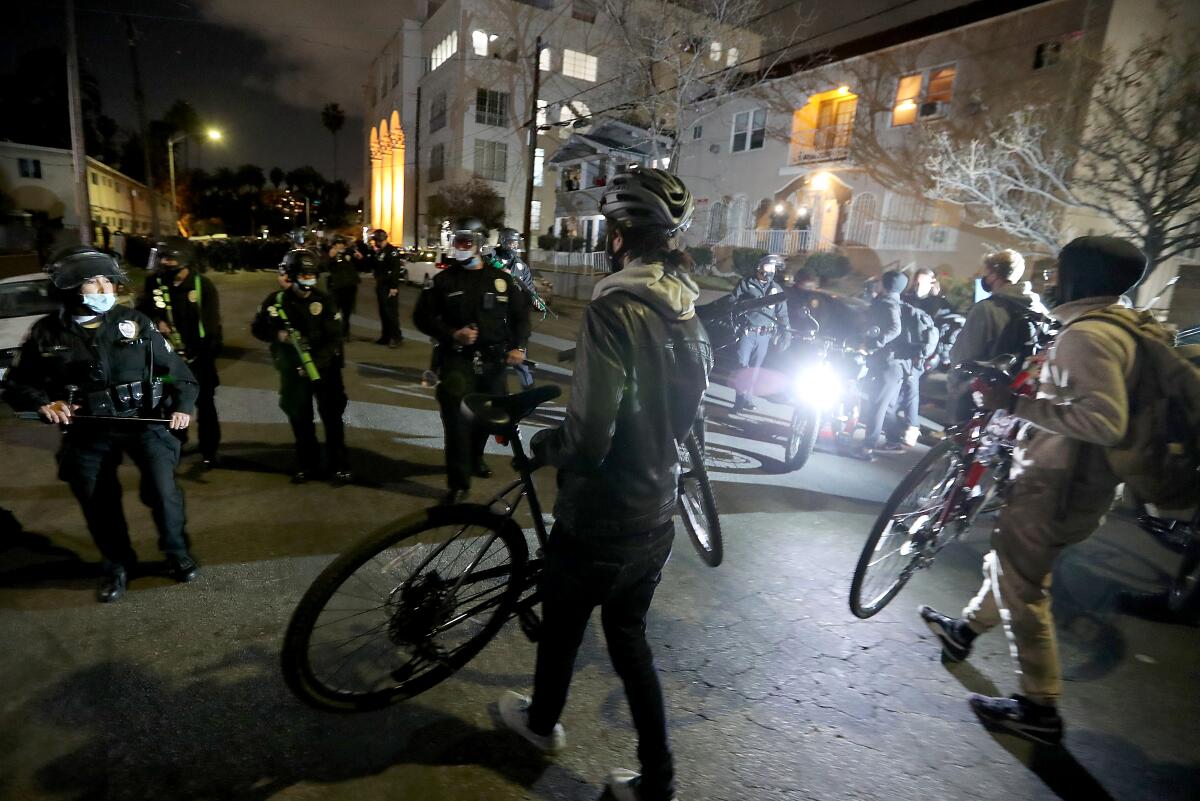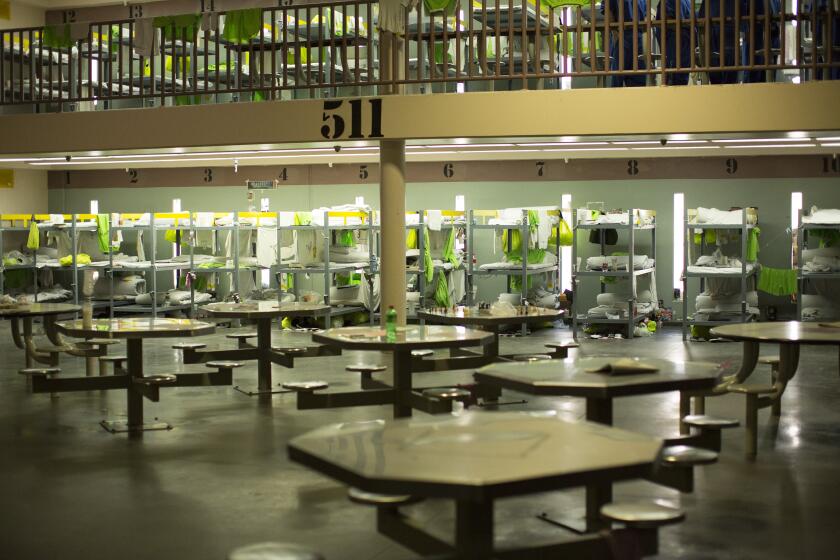LAPD report on Echo Park homeless camp cleanup finds ‘room for improvement’

- Share via
A Los Angeles Police Department report on the Echo Park closure and resulting protests in March found several shortcomings in the department’s response, including insufficient tracking of projectile weapons and poor communication with media in the field.
The report concluded that the closure and subsequent fallout — which occurred after city officials determined that a homeless encampment in the park had grown out of control, necessitating repairs — might have been avoided if municipal park rangers had prevented the encampment’s expansion.
“Had the encampment in Echo Park been adequately addressed in its early stages, there never would have been a need for a full-scale closure,” the LAPD concluded in its “After Action Report,” released Friday.
“Currently, Park Rangers are missing nearly half their allotted positions. They simply do not have the resources to monitor every park in the City,” the LAPD report states. “To prevent another encampment from establishing itself in a popular public space, the City should make fully staffing the Park Rangers a top priority.”
The report acknowledges few other mistakes in the department’s response but does make several recommendations for how such incidents could be better handled in the future.
A spokeswoman for the Park Rangers did not immediately respond to a request for comment Saturday.
The report is set to be discussed at the civilian Police Commission’s weekly meeting Tuesday.
The March events brought intense scrutiny to the LAPD at a time when it was still taking stock of last year’s protests after the murder of George Floyd and came amid growing tensions in the city around the utilization of public space by people experiencing homelessness.
Those tensions have only increased. The City Council this week passed a law that further restricts homeless encampments in the city and could lead to new clearance efforts.
Activists who showed up to protest the clearing of the Echo Park encampment joined members of the media who were covering the event in criticizing the LAPD response. The police action resulted in more than 180 detentions and arrests, including of journalists, and cost the city and the police department millions of dollars in operational and overtime costs, according to the report.
One protester had his arm broken by an officer swinging a baton. Protesters and members of the media were shot with hard-foam projectiles and bean-bag rounds, at times at close range. Protesters and legal observers cried foul, alleging excessive force. Reporters, including The Times’ James Queally, were caught up in the enforcement action and detained; others were arrested.
In the days after the protests, the bulk of which occurred over the course of two nights in late March, LAPD Chief Michel Moore credited the department with maintaining safety in a volatile situation that saw people lobbing water bottles and firecrackers at officers, and protesters locking arms to prevent officers from arresting those responsible.
Moore said the department had done a better job than it had the previous spring at limiting the use of projectile weapons and processing detainees swiftly.
However, Moore said the department had received complaints about Echo Park — including from the media — and would be reviewing its operation and the circumstances that led up to it. He said it was clear the city needs a better plan for addressing homeless encampments.
In a July 22 letter accompanying the report to the Police Commission, Moore said the department has “made great strides in addressing weaknesses” in its handling of mass demonstrations since the 2020 unrest, but the events in Echo Park showed that “there continues to be room for improvement.”
The report noted that the closure of the park was scheduled to occur a year earlier, in March 2020, after City Councilman Mitch O’Farrell, who represents the area, determined it was necessary for repairs to be made. However, the COVID-19 pandemic put those plans on hold.
The report said efforts by the city to find housing for individuals who were living in the park failed, with some expressing no desire to leave.
The report said the idea to close the park resurfaced in December, but the LAPD requested that the action be delayed because it was short-staffed while experiencing a wave of coronavirus infections among officers.
“Between Dec. 1, 2020, and Jan. 31, 2021, 1,684 LAPD employees tested positive for COVID-19 and were forced to quarantine for at least 14 days,” the department reported. “The loss of such a significant portion of the Department’s workforce created massive ripples across the organization that drastically effected the Department’s ability to conduct daily operations.”
Efforts were again made to house people in the park, this time with the assistance of outreach company Urban Alchemy, until a decision was made to move forward with the closure in March.
“As the entity responsible for public safety, and due to the sheer number of personnel that would be required to successfully secure such a large perimeter while the fence was being constructed, the LAPD took a leading role in operationalizing the closure,” the LAPD report said.
On the night of March 24, the plan was put into action. Protesters responded, and there were some clashes with police. Few arrests were made.
The night of March 25, protesters in the area used strobe lights, police said, to make it difficult for officers to see what was going on. Protesters again said the LAPD was aggressive in staging across from protesters who were exercising their free speech rights.
That night, the LAPD declared an unlawful assembly; “kettled,” or surrounded, protesters who did not disperse as ordered; and arrested more than 180 people, including journalists. City Atty. Mike Feuer later determined that those arrested for failure to disperse would not be charged.
According to the new report, the LAPD had as many as 750 officers deployed to Echo Park during the March events and spent more than $1.1 million on regular salaries and more than $900,000 on overtime, among other costs.
The LAPD received 12 complaints related to its protest response, including one from protester Isaac Scher, whose arm was broken. Another complaint is related to the detention of Queally. An internal review found that a sergeant made an “improper remark” after the reporter requested to speak to a supervisor, according to the report.
The report determined that the LAPD should devise a better system for tracking the use of projectiles on crowds, as “there is a large gap between the level of documentation” for such incidents versus similar uses of force in non-protest settings, which are better documented.
The report also found that the LAPD “needs to provide formal guidance to address the rise of independent journalists, reporters and ‘observers’ in today’s culture,” as well as “consider publishing a formal policy or specific guidance regarding what actions field supervisors and officers should take when [they] detain someone at the scene of an unlawful assembly.”
It also said the department should deploy more of its own personnel to film such encounters in order to preserve evidence.
More to Read
Sign up for Essential California
The most important California stories and recommendations in your inbox every morning.
You may occasionally receive promotional content from the Los Angeles Times.











